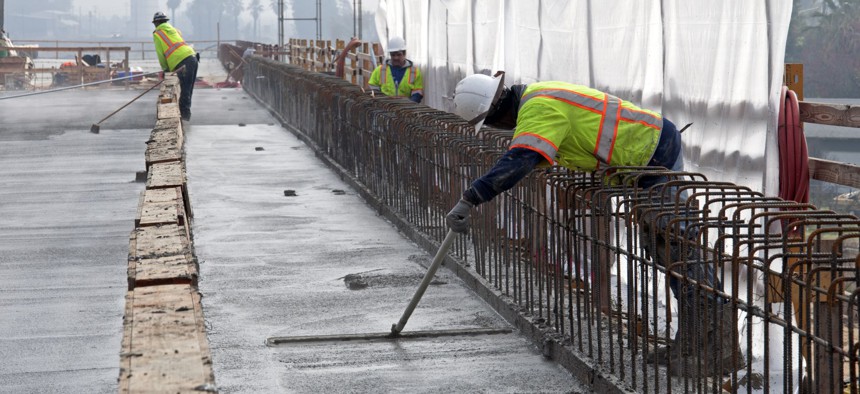Connecting state and local government leaders
In California’s Central Valley, financial incentives and the prospect of a future high-speed rail connection to the Bay Area are helping to drive development. But there’s some uncertainty, too.
Editor’s Note: This is the next installment in an ongoing series of articles examining economic development challenges in cities and localities and the second of two parts looking at Fresno, California. | PREVIOUSLY: Fresno, California (Part 1)
If California’s high-speed rail project continues as planned, then about eight years from now trains would whisk passengers along at over 200 mph on rails connecting Fresno and San José.
“That’s a game changer,” said Dan Zack, Fresno’s assistant planning director.
Fresno is an agricultural hub in California’s Central Valley. Located in Silicon Valley, San José has a prosperous technology sector and some of the nation’s highest housing costs. It now takes about three hours to make the roughly 150-mile drive between the two cities. The train line would cut the trip to around one hour, according to the state’s High-Speed Rail Authority.
Set against the backdrop of plans for the railway is an ongoing push by Fresno’s local government and private developers to breathe fresh life into the city’s downtown. Once vibrant, downtown Fresno deteriorated in recent decades as the city sprawled northward.
The effort to revive the area appears to be making progress. But there are caveats.
Uncertainties about funding plague California’s bullet train plans, while critics have argued that the project has become an expensive and disruptive mess.
Developers, meanwhile, say some of the real estate projects taking shape in downtown Fresno would not make financial sense without government financial incentives.
Adding another layer of complications: 29 percent of the city’s 520,000 residents were estimated to be in poverty, according to U.S. Census Bureau figures for 2011 to 2015, raising questions about how new real estate development can be balanced with demands for affordable housing.
Betting on Downtown
Terance Frazier, CEO of TFS Investments, LLC, is a real estate developer in Fresno.
Among the projects he’s working on is a building in downtown that would have 51 residential units, along with ground floor retail and office space. There would also be amenities such as a pool and a rooftop bar overlooking Chukchansi Park, home of the city’s minor league baseball team, the Fresno Grizzlies.
Frazier imagines downtown as a place where residents might one day commute to the San Francisco Bay Area for work, and travel between their homes and the train station on golf carts.
“People are just going to get off the high-speed rail, get on a golf cart, go to the club, have a good time, walk to their apartment,” he said. The next day, he added, they could go back to the “high-speed rail and be working in Oakland…That’s what I envision.”
Frazier is not the only one betting on downtown Fresno.
As of September, about $154 million of new private sector construction was planned, underway, or had been recently completed in the area, according to a report from the Downtown Fresno Partnership. This real estate development included 447 residential units.
“We’re on my fifth project downtown,” said William Dyck, another local developer who focuses on commercial real estate.
“Every one of them has been basically privately funded,” he added. “They’re fully leased.”
The downtown partnership points to new businesses in downtown Fresno that are open, or in the works—coffee shops, gyms, a new facility where a local restaurant plans to produce tamales for wholesale distribution. Technology firms are taking notice of the city, too. “Amazon is looking like it might come to town,” Zack said. Local tech company Bitwise Industries is expanding.
What does the city have to offer? “Some of it’s probably just cost of living,” said Aaron Blair, the Downtown Fresno Partnership’s president and CEO. “And some of it’s the thought of the high-speed rail project connecting us more to Silicon Valley.”
Blair also noted that from Fresno there’s easy access to the Sierra Nevada mountains and Yosemite National Park, where outdoor recreation opportunities abound. And that the city does not have the kinds of commutes that can bedevil people in bigger metropolitan regions.
“When you really sit back and take a look at it,” Blair said, “people are going, ‘oh wow, I could live a lot better life in Fresno, instead of sitting in my car for hours.’”

‘Force to Help Focus Development’
Dan Richard, who chairs the board of directors for the state’s High-Speed Rail Authority, draws a direct link between economic improvement in cities such as Fresno and building the railway.
“We would like to be a force to help focus development in these downtown areas and help revitalize them,” he said last month. Richard noted that high-speed rail stations can create billions of dollars of value in areas where they are built, by sparking new economic activity.
As planned, the complete California high-speed rail system would cost an estimated $64 billion, and would run between Los Angeles in the south and San Francisco in the north. Extensions would eventually provide service to San Diego and the state capital, Sacramento.
The initial stretch of rail slated for construction would run from San José to farmland near Shafter, a city south of Fresno, and just northwest of Bakersfield. It’s expected to open by 2025. At that time, trains would also run at slower speeds to and from San José and San Francisco.
Some have questioned the wisdom of building this first segment of the line while there is still uncertainty about how the state will fund the rest of the system. U.S. Rep. Jeff Denham, a California Republican, said at a House rail subcommittee meeting in August: “You could be stuck in a field somewhere between Shafter and Wasco … and … out of money.”
The High-Speed Rail Authority’s business plan calls for building the initial section of the line, and finding a private entity that will pay for the right to operate the railway. The money the state earns from that arrangement would then be invested to build additional parts of the system.
But even the funding for the link between San José and Shafter is not completely secure.
This is partly because a portion of the money for high-speed rail is supposed to come from California’s cap-and-trade program. The program involves credits, which are sold at auction, and can be purchased by businesses like oil refineries to offset their greenhouse gas emissions. State lawmakers allocated a quarter of these auction proceeds for the bullet train project.
But the cap-and-trade program is under fire in court and has encountered other difficulties as well. A lawsuit first filed about four years ago by the California Chamber of Commerce continues to pose a threat. Some critics argue the program does not have the legal authority to exist past 2020. And revenues from the credit auctions have at times fallen short of expectations.
Should the cap-and-trade program end, Richard estimated that there would be somewhere around a $7 billion shortfall for the roughly $21 billion needed to build the leg of railway that would link the Central Valley and Silicon Valley.
“If the cap-and-trade program stabilizes, we will have enough money to connect Fresno to the Bay Area,” Richard said. “If it doesn’t, then we’ll be seeking some additional funding sources.”
‘Everybody's Got Skin in the Game’
For Frazier, the residential developer, it is more than the prospect of a high-speed rail station in downtown Fresno that convinced him to build in that part of town. A project to remake the site of a 1960s-era pedestrian mall on Fulton Street also influenced his decision-making. So did plans for upgraded bus service and changes to the local municipal codes that guide development.
But government financial incentives were also an important factor.
For downtown developers, Fresno has waived certain “impact fees,” which are meant to help cover city expenses tied to police and fire services and city streets. “It can be anywhere from [$300,000] to $500,000 in some cases,” Lupe Perez, the city’s downtown revitalization manager, said last month as she discussed the savings for developers from the fee waivers.
According to Frazier, when it comes to residential real estate projects in downtown Fresno, without incentives it’s hard to make the finances work.
He offered the planned 51-unit building as an example.
“We had like a $9 million gap,” Frazier said. But the city stepped in to help. The Fresno City Council agreed last February to waive about $500,000 worth of impact fees and to sell land valued at roughly $430,000 to Frazier and another developer for $3.
“The city right now, they're not making any money on just a vacant lot,” Frazier said as he discussed the land deal. “Once our project is done, it’s a $16 million project, they’ll make their money back from the tax increases.”
Frazier explained that because the project is subsidized, 80 percent of the units in the completed building will fetch market rate prices, while another 20 percent, or 10 of them, must be “affordable.” Some of the affordable units could possibly rent for as little as about $500 per month, he said.
About $5.7 million in state funds from the cap-and-trade program would offer the project an additional boost, Frazier noted. And the city applied for roughly $711,000 through a county program, funded by a half-cent sales tax, that supports land use changes meant to increase demand for transit. “I’m going to have to put up the rest,” Frazier said of the money it would take to close the $9 million gap—a ballpark figure for that amount is $1.5 million.
“Everybody’s got skin in the game,” Frazier added. But without the subsidies “there is no way” he would do the project. “It doesn’t make money sense,” he said. “It would be stupid.”
Frazier sees promising signs the local economy will be able to support a downtown rental market for the type of housing he’s ideally seeking to build—places with apartments that will attract two or three young professionals per unit, who will split rent around $1,800 each month.
“If the market does what normal cities do,” he said, “we’re going to be fine.”
But there’s another issue that he said could become problematic.
“I believe we’re going to run out of affordable units,” he said. “If you don't put some affordable units in these downtown areas, you’ve got a huge gentrification issue,” Frazier added. “We all recognize that. It can’t be all market rate. But we can’t be all affordable.”
Bill Lucia is a Senior Reporter for Government Executive's Route Fifty and is based in Washington, D.C.

NEXT STORY: Google's Eric Schmidt Tells Trump to Upgrade Government IT




